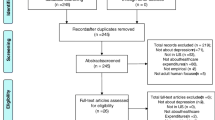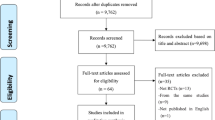Abstract
The purpose of this study was to formulate and test two case-mix models for depression treatment that permit comparisons of patient outcomes across diverse clinical settings. It assessed demographics; eight, diagnostic-specific, case-mix variables; and clinical status at baseline and follow-up for 187 patients. Regressions were performed to test two models for four dependent variables including depression severity and diagnosis. Individual treatment settings were then ranked based on a comparison of actual versus predicted outcomes using regression coefficients and predictor variables. A model inclusive of baseline physical health status and depression severity predicted depression severity, mental health, and physical health functioning at follow-up. A simpler model performed well in predicting depression remission. This study identifies variables to be included in case-mix adjustment models and demonstrates statistical methods to control for differences across settings when comparing depression outcomes.
Similar content being viewed by others
References
Keeler EB, Kahn KL, Draper D, et al. Changes in sickness at admission following the introduction of the prospective payment system.Journal of the American Medical Association. 1997;264:1962–1968.
Fortney JC, Booth BM, Smith GR. Variation among VA hospitals in length of stay for treatment of depression.Psychiatric Services. 1996;47:608–613.
Hodges K, Wong MM. Use of the child and adolescent functional assessment scale to predict service utilization and cost.The Journal of Mental Health Administration. 1997;24:278–290.
Horn SD, Chambers AF, Sharkey PD, et al. Psychiatric severity of illness: a case mix study.Medical Care. 1989;27:69–84.
Hendryx MS, Dyck DG, Srebnik D. Risk-adjusted outcome models for public mental health outpatient programs.Health Services Research. 1999;34:171–195.
Sherbourne CD, Hays RD, Wells KB. Personal and psychosocial risk factors for physical and mental health outcomes and course of depression among depressed patients.Journal of Consulting and Clinical Psychology. 1995;63:345–355.
Wells KB, Burnam MA, Rogers W, et al. The course of depression in adult outpatients: results from the Medical Outcomes Study.Archives of General Psychiatry. 1992;49:788–794.
Iezzoni LI.Risk Adjustment for Measuring Health Care Outcomes. 2nd ed. Melrose Park, IL: Health Administration Press; 1997.
Smith GR, Burnam A, Burns B, et al.Major Depression Outcomes Module: User's Manual. Little Rock, AR: University of Arkansas for Medical Sciences; 1994.
Kramer TL, Smith GR. Tools to improve the detection and treatment of depression in primary care. In: Maruish MEP, ed.Handbook of Psychological Assessment in Primary Care Settings. Manway, NJ: Lawrence Erlbaum Associates; 1999.
Rost K, Smith GR, Burnam MA, et al. Measuring the outcomes of care for mental health problems: the case of depressive disorder.Medical Care. 1992;30(5, suppl):MS266-MS273.
Rost K, Williams C, Wherry J, et al. The process and outcomes of care for major depression in rural family practice settings.Journal of Rural Health. 1995;11:114–121.
Ware JE, Sherbourne CD. The MOS 36-item short-form health survey (SF-36): conceptual framework and item selection.Medical Care. 1992;30:473–483.
Ellwood PM. Shattuck lecturee—Outcomes management: a technology of patient experience.New England Journal of Medicine. 1988;318:1549–1556.
Ware JE, Kosinski M, Bayliss MS, et al. Comparison of methods for the scoring and statistical analysis of the SF-36 health profile and summary measures: summary of results from the Medical Outcomes Study.Medical Care. 1995;33:AS264-AS279.
Ware JE, Snow KK, Kosinski M.SF-36 Health Survey Manual and Interpretation Guide. Boston: New England Medical Center, Health Institute; 1993.
American Psychiatric Association.Diagnostic and Statistical Manual of Mental Disorders, Fourth Edition. Washington, DC: American Psychiatric Association; 1994.
Zimmerman M, Coryell W, Corenthal C, et al. A self-report scale to diagnose major depressive disorder.Archives of General Psychiatry. 1986;43:1076–1081.
Spitzer RL, Williams JBW, Gibbon M, et al. The structured clinical interview for DSM-III-R (SCID) 1: history, rationale, and description.Archives of General Psychiatry. 1992;49:624–629.
National Center for Health Statistics.Current Estimates from the US National Health Interview Survey. Washington, DC: Government Printing Office; 1989.
Tarlov AR, Ware JE, Greenfield S, et al. The Medical Outcomes Study: an application of methods for evaluating the results of medical care.Journal of the American Medical Association. 1989;262:925–930.
Robins LN, Helzer JE, Croughan J, et al. National Institute of Mental Health Diagnostic Interview Schedule: its history, characteristics and validity.Archives of General Psychiatry. 1981;38:381–389.
Andreasen NC, Endicott J, Spitzer RL. The family history method using diagnostic criteria.Archives of General Psychiatry. 1977;34:1229–1235.
Carlin BP, Louis TA.Bayes and Empirical Bayes Methods for Data Analysis. Boca Raton, FL: Chapman & Hall/CRC; 2000;46–47.
Mosteller F, Tukey JW.Data Analysis and Regression: A Second Course in Statistics. Reading, MA: Addison-Wesley; 1977;37.
Bovasso GB, Eaton WW, Armenian HR. The long-term outcomes of mental health treatment in a population-based study.Journal of Consulting and Clinical Psychology. 1999;67:529–538.
Goldberg DP.The Detection of Psychiatric Illness by Questionnaire. London: Oxford University Press; 1972.
Sun GW, Shook TL, Kay GL. Inappropriate use of bi-variable analysis to screen risk factors for use in multivariable analysis.Journal of Clinical Epidemiology. 1996;49:907–916.
Barnow BS, Cain GG, Goldberger AS. Issues in the analysis of selectivity bias.Evaluation Study Review Annual. 1980;5:43–59.
Breen R.Regression Models: Censored, Sample Selected or Truncated Data. Thousand Oaks, CA: Sage; 1996.
Moffitt R. Program evaluation with non-experimental data.Evaluation Review. 1991;15:291–314.
Author information
Authors and Affiliations
Corresponding author
Rights and permissions
About this article
Cite this article
Kramer, T.L., Evans, R.B., Landes, R. et al. Comparing outcomes of routine care for depression: The dilemma of case-mix adjustment. The Journal of Behavioral Health Services & Research 28, 287–300 (2001). https://doi.org/10.1007/BF02287245
Issue Date:
DOI: https://doi.org/10.1007/BF02287245




